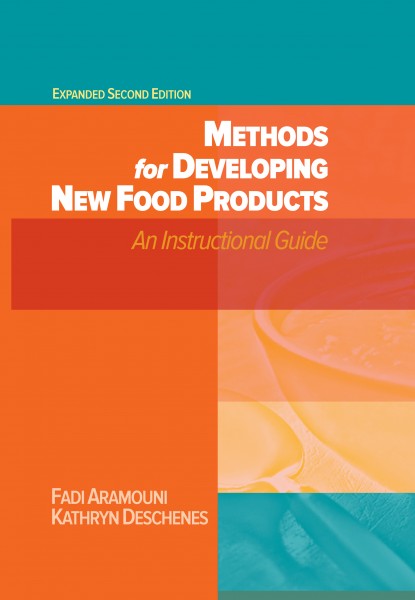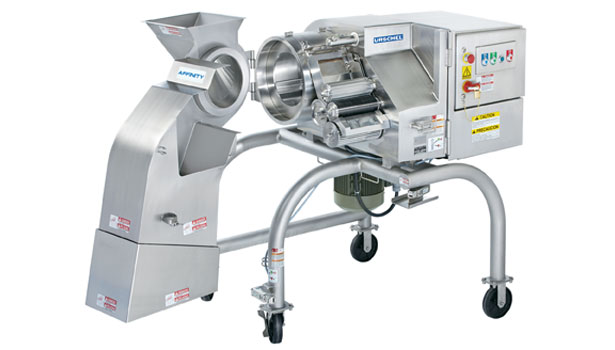Article Index:
The same holds true for food preparation on an industrial scale. The main difference is that the knives and other tools are replaced by sophisticated and often computerized grinding, cutting, dicing, shredding and cubing machines that churn out pieces of food in precise sizes and shapes, either for end-use as is or ingredients for further production.
According to Munson Machinery Marketing and Technology Manager Steve Knauth, high throughput continues to be the primary thing producers need. Other key elements include easy and effective cleaning, operator safety and accurate, consistent sizing.
“The greatest challenges in producing size reduction machinery for food processing applications,” says Knauth, “are delivering accurate results consistently and achieving high throughput at the lowest cost per unit of volume or weight of material reduced, while cutting the customer’s costs related to cleaning, downtime and labor.”
Another important aspect is food safety. Increasing recalls and foodborne illnesses over recent years have prompted governments worldwide to strengthen food safety legislation. The Food Safety Modernization Act in the US and the Safe Food for Canadians Act are two examples. This focus on food safety has led to the appearance of more machines that are easier to clean and sanitize.
A case in point is the Munson pin mill, which is used for the fine and ultra-fine particle reduction of sugars, starches, salts, spices and other items. “The unit has become popular in sanitary food applications because it provides high output and tends not to build up residues,” says Knauth. “When it’s time for maintenance, cleaning is relatively straightforward because the unit has only one moving part, which is the rotor.” It also has a large door that opens fully for unrestricted access to internal surfaces and an access panel at the rear for quick, thorough washdowns with water, steam or cleaning solutions.
Munson’s low-profile rotary lump breaker, used to break down chunks of sugar, salt and powdered dairy products, has become popular for similar reasons. It features removable side screens for thorough cleaning and easy interior access, as well as split seals for servicing. It also has a rugged overall construction and outboard bearings for easy lubrication. As with the pin mill, metal guards cover the moving parts, and proximity switches shut down the unit automatically when it’s opened, ensuring operator safety.
Munson equipment consistently delivers accurately cut food pieces. This is critically important for manufacturers, not only because it’s what they expect, it also saves production costs by reducing waste in product losses and production time.
Value before price
David Penta, president of Deville Technologies, says processors are also looking for streamlined, sanitary-designed equipment that offers maximum uptime with a superior, accurate cut quality. “Our customers are continuously faced with increased competition that erodes their margins, so the only thing they can do is work more efficiently than their competitors,” he explains.
When shopping for the right unit, Penta says processors should put value ahead of price. “Will the solution I’m buying save me more than what other vendors are offering? Will I need more labor on repairs or lose product on the floor because of poor integration? Will it take more time to clean because of hard-to-get-at nooks and crannies? How simple is the unit to disassemble and reassemble for cleaning? Are covers hinged or removable, and is the equipment built to the latest sanitary design standards?”
One of Deville Technologies’ flagship products for cheese and meat is the high-capacity FS40 shredder. It can handle up to 14,000 pounds per hour and take whole blocks of cheese at a time without the added step of pre-cubing, thereby increasing productivity while decreasing labor and equipment requirements.
No pre-cubing also reduces the size and complexity of the equipment, meaning fewer surfaces where dirt and bacteria could collect. “High capacity also means less equipment which, in turn, means fewer surfaces and lower sanitation risk,” adds Penta.
One of the latest trends in sanitary design is solid materials, according to Penta. Processors are increasingly asking for a chassis built out of solid materials as opposed to hollow tubing to eliminate the risk of dirty rinse water penetration due to metal fatigue.
Thanks to these and other features, the FS40 shredder has earned USDA acceptance for cheese applications. On the dicing side, the company’s main offering is the Deville Hymaks line, which is USDA accepted as well.
The quality of after-sales service is another important component. For instance, processors need to know if the supplier stocks spares and if parts can be shipped overnight. Knauth also suggests finding out whether the equipment supplier has test facilities with the full-scale equipment to do trial runs.
Urschel Laboratories offers over 50 types of cutting machinery, including potato chip slicers; high-capacity cheese shredders; dicers for fruit, vegetables and meat; peanut butter mills; and lettuce shredders.
Tim O’Brien, vice president of sales, says all the attention given to food safety during recent years, along with new food safety legislation, is largely what led Urschel to introduce its new line of Affinity USDA Dairy Division-accepted dicers. “They are our most sanitary machines,” says O’Brien. “The dicers have smooth RA 32 finishes, are very cleanable, come apart easily with minimal tools and have rounded corners and sloped surfaces to prevent the collection of water.”
In addition to dicing cheese, the units are used for meats and vegetables. Most Urschel machines, including the Affinity dicers, are high capacity. To cater to smaller producers, the company recently developed its ETRS slicer and Sprint dicer. “Both are priced in the $30K to $40K range,” explains O’Brien.
Reducing explosion risk
Prater-Sterling manufactures fine grinders, classifier mills, hammer mills and lump breakers for reduction applications ranging from six inches to submicron sizes. The company also produces rotary sifters for products such as flour and quick-take-apart airlocks to move flour and a variety of other powder products around the plant.
Regional Sales Manager Darrell Malczewski says the company sells a lot of grinding equipment to the sugar industry, which requires equipment capable of withstanding an explosion. “Because of this concern, Prater’s M-51 fine grinder comes with an option that enables it to withstand shock pressures up to 10 Bar [145 psi] without fragmenting or flying apart,” he says. “In the rare event of an explosion, our designs prevent the mill body from rupturing, which could injure people or property or create a spark for a larger explosion in a powdery environment.”
To keep airborne powder levels and explosion risk to a minimum, the M-51’s door is secured by a rubber O-seal, and the shaft is tightly sealed to keep dust inside the grinder. The bearings are located away from main powder areas and sealed, so they don’t require lubrication, cutting down on maintenance.
The secret’s in the grind
The coffee industry, like all others, continues to evolve. “What used to be like walking on the sidewalk with traditional brewed coffee is now like walking on a tightrope with pods and capsules,” observes Scott Will, director of sales at Modern Process Equipment.
Regular brewing, which takes several minutes through percolator and drip methods, now takes 30 seconds or less in today’s push-button countertop machines. As a result, the need for grind accuracy and grind variety has increased dramatically.
The IMD 700 Series Granulizer is one of MPE’s most technically advanced coffee grinders. Able to provide the accuracy and range today’s producers require, it processes between 600 and 2,000kg of ground coffee per hour; a recipe-driven PLC control system monitors and controls all aspects of grind size and density with real-time performance feedback.
“The real-time feature enables the machine to make adjustments on the fly, compared to more basic units, where operators make random checks and subsequent time-consuming adjustments manually,” says Will. “Grinding temperatures are kept in check with a water cooling system to protect quality.”
The unit also can provide optional bimodal or plurimodal grinding, where coarser particles and finer particles are ground simultaneously and mixed according to the recipe. Coarser particles enhance water flow; finer particles enhance extraction.
The IMD 700 comes in a smaller version—the IMD 600—that is basically the same unit but with a capacity ranging from 300 to 1,000kg per hour.
Blade innovation
Knife technology is fundamental to all companies that specialize in food size reduction, but doesn’t mean they necessarily produce knives themselves. Peter Johnson, Carruthers general manager, says his company outsources its blades to specific vendors. “They are experts in making knives, while we specialize in building the whole machine,” he notes.
Carruthers works closely with its suppliers to develop the blades it needs for units such as its AdvantEdge AE 5000 series dicers and slicers. “At the time, we noticed many of the machines on the market didn’t do a great job on fresh products,” recalls Johnson. “We realized the best cutting was always done manually, so we tried to mimic a hand-cutting process in our machines, and it worked.”
AdvantEdge AE 5000 machines can not only dice and slice, they strip-cut as well. “Processors can do all three in one machine,” says Johnson. “Our customers say, ‘We grew our business by buying your machine because it gave us more applications.’”
It has also given processors a leg up on quality. One example is a major US chicken processing plant that wasn’t satisfied with the cube shapes produced by its existing dicing equipment and wanted to increase the number of larger-sized pieces and reduce fines.
When the processor conducted a test comparing its existing dicer with the Carruthers AdvantEdge AE5000, running 364kg (800 lb.) of product through each machine at the same cut size and temperature, the AdvantEdge unit produced 20 percent more of the desirable cube sizes (in the 8 to 16mm range) and reduced the number of undesirable (less than 8mm) cubes by close to 16 percent. Today, the producer uses its Carruthers AdvantEdge AE5000 unit to dice five tons of poultry per hour, 16 hours a day, six days a week.
For more information:
Steve Knauth, Munson Machinery, 800-944-6644, sknauth@munsonmachinery.com, www.munsonmachinery.com
David Penta, Deville Technologies, 514-366-4545, dpenta@devilletechnologies.com, www.devilletechnologies.com
Darrell Malczewski, Prater-Sterling, 630-679-3242, dmalczewski@praterindustries.com, www.praterindustries.com
Scott Will, Modern Process Equipment, 773-254-3929, scott@mpechicago.com, www.mpechicago.com
Tim O’Brien, Urschel Laboratories, 219-464-4811, tobrien@urschel.com, www.urschel.com
Peter Johnson, Carruthers, 503-468-0441, petej@carruthers.us, www.carruthers.com
























